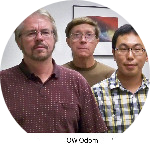About This Project
We are developing strains of the green alga Chlamydomonas that are specifically lethal to larvae of the mosquitoes that transmit Zika. Mosquitoes are major disease vectors that transmit several viruses for which there are no effective treatments; thus, mosquito control is our best chance for prevention. Chemical pesticides for mosquitoes fail eventually due to resistance, and new methods are sorely needed. Our approach is novel, has considerable potential, and can be sustainable.
Ask the Scientists
Join The DiscussionWhat is the context of this research?
Mosquito control has been essential to limiting diseases that are transmitted by these insects, including the Zika, West Nile and dengue viruses, and the malarial parasite. However, the control of these pests is being challenged by increasing resistance of mosquito populations to chemical pesticides, and climate change, which is expanding the tropical regions of the globe (and with it an increasing threat of tropical diseases in temperate regions, such as the US). Our project is a novel approach to help control mosquitoes that will be safe and sustainable, as it is based partly on protein biolarvacides that have been used for many years to control mosquito diseases (Ramirez-Lepe and Ramirez-Suero, 2012), and partly on a green alga that grows and swims in larval habitats.
What is the significance of this project?
There is no single approach that can stop mosquitoes, and so most mosquito control programs use a suite of control measures that target both larval and adult stages of the insect's life cycle. Pesticides are a key part of these control measures, but the majority target the adult stage; however, female adult insects are already competent to bite and transmit viruses. We are focused on stopping these pests at the larval stage, before they become biting adults. All mosquito larvae develop in water, where they consume algae, bacteria and decaying particles to fuel their growth. And it is here that we can turn a potential algal food source into a "Trojan Horse" that will specifically damage only mosquito larvae.
What are the goals of the project?
We are using precise genetic technology to modify Chlamydomonas, which would normally be an excellent food source, to make 3 proteins in its chloroplast that are specifically toxic to mosquito larvae. We have already demonstrated that the chloroplast can make each of these proteins separately, now we must combine them in the same strain. The proteins are based on the biopesticidal proteins from Bacillus thuringiensis israelensis (Bti). Although Bti is the safest mosquitocide, since it is a protein complex it does not recycle. Also, it is deactivated quickly in certain habitats (polluted), further reducing its usefulness. However, mosquitoes have not been able to develop strong resistance to it. Hence, our algal strains will eliminate most of Bti's limitations, while keeping its strengths.
Budget
The personnel request ($6000) is for a stipend for Seongjoon Kang, who has been demonstrating the feasibility of producing Chlamydomonas strains lethal to mosquito larvae as part of his PhD thesis. The new combination strains that he will create follow from that work, and will demonstrate with a high degree of certainty that we can produce strains that are highly toxic to mosquito larvae (Aedes aegypti and Culex spp). That should enable us to obtain funding from federal or private sources to further enhance (if needed) and commercialize the algal strains.
The remaining request ($2000) is to cover part of the costs of the consumables, which include anti-Flag antibody ($350), western detection reagents ($600), enzymes for molecular biology ($500), and plastic consumables ($550). The mosquito larvae will be provided by a collaborative arrangement with UTMB-Galveston.
Endorsed by
Meet the Team
Team Bio
The 3 of us have worked together for 7 years (2 of us, much longer), and are uniquely qualified for this project. Our lab has made a number of seminal discoveries in chloroplast molecular biology using Chlamydomonas. Now, we are pioneering the development of this alga as a biological control agent against mosquitoes. It is particularly exciting, because it represents a new direction for us (public health) and it is an opportunity to make a real impact in people's lives!
David L Herrin, OW Odom, Seongjoon Kang
David L. Herrin is currently Professor of Molecular Biosciences at UT-Austin. He first joined the University in 1988 as an Assistant Professor of Botany, after completing his PhD and postdoctoral training at the University of South Florida and University of Georgia, respectively. He studied chloroplast and plant molecular biology using Chlamydomonas, since he was a graduate student. The Herrin lab's research has been supported by grants from federal agencies, state agencies, and private foundations.
Dr O.W. Odom received his PhD in Biochemistry from the University of Tennessee, and did postdoctoral work on the biochemistry of protein synthesis with Boyd Hardesty at the University of Texas at Austin. He joined the Herrin lab in 1997 as a Research Scientist, where his background in protein biochemistry meshed well with Herrin's expertise in chloroplast gene expression. Dr Odom's knowledge of protein biochemistry has been instrumental for working with the Bti proteins.
Seongjoon Kang joined the Herrin lab as an undergraduate researcher in 2008. After obtaining his Bachelor's degree in 2009, he entered the Plant Biology Graduate Program and continued in the Herrin lab as a PhD student. He received his PhD last year from UT-Austin, based in part on his accomplishments with this project. Indeed, Seongjoon's success in producing Chlamydomonas strains that produce single Bti proteins, together with his keen interest in providing a public health solution, have propelled him to continue working on this project as a postdoctoral researcher.
Lab Notes
Nothing posted yet.
Project Backers
- 6Backers
- 5%Funded
- $364Total Donations
- $60.67Average Donation


